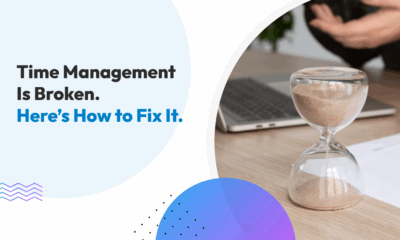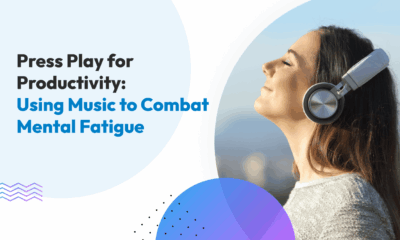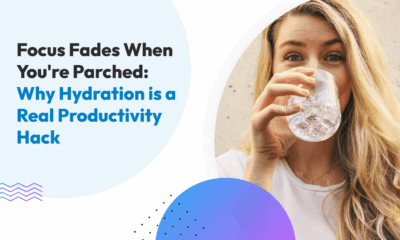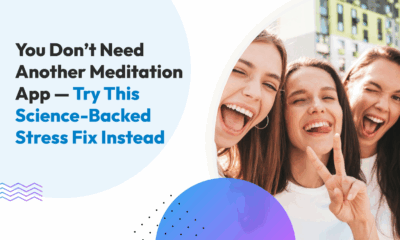Science Says
Working Fewer Hours Won’t Save You — But This Will
So many people, from content creators to freelancers and business owners, have been talking about burnout. It’s even covered in the media. But the suggestions from articles like those include reducing stress and taking more time off.
Wrong. Fixing workload doesn’t fix burnout. That’s actually GREAT news for those of us who shoulder a lot of responsibility. It’s also why so many seem stuck in a burnout cycle. They’re focusing on the wrong fix.
Let me tell you about last weekend. There I was, in sunny San Diego, perfect patio weather, and I’m glued to my laptop watching YouTube videos about… YouTube. Not cat videos. Not entertainment. Educational content about growing a YouTube channel. On a SATURDAY.
My partner’s giving me the look. You know the one. The “weren’t we supposed to be relaxing?” look.
Here’s the thing, though: I wasn’t forcing myself. I was genuinely having fun. My brain was firing with ideas, making connections, feeling that delicious curiosity that makes time disappear. But I also knew that if I kept going like this, come Monday, I’d be toast.
This is exactly where most productivity advice gets it wrong. We’re told to maintain strict schedules, work set hours, and create rigid boundaries. But that advice assumes we’re machines with consistent output capacity.
We’re not. And science supports what our bodies have been trying to tell us all along.

Your Brain Has Seasons (And Fighting Them Is Making You Miserable)
Think about the last time you tried to force yourself to be productive when your brain felt like mush. How’d that go?
Now think about a time when you were so absorbed in work that stopping felt painful.
Those aren’t random fluctuations. They’re natural phases your brain cycles through, and research shows they’re not character flaws; they’re literally how we evolved to work optimally.
Neuroscience research has mapped these distinct motivation phases. Your brain actually recruits different neural networks during different phases: the ventral striatum for reward-driven tasks, the orbitofrontal cortex for decision-making, and the anterior cingulate cortex for goal-directed control¹. You can think of motivation phases like seasons.
High Motivation Phase (Your brain’s summer):
- Natural gravitational pull toward work-related content
- Ideas flowing easily without forced effort
- Genuine curiosity about projects
- Difficulty stopping work (in a positive way)
Recovery Phase (Your brain’s winter):
- Difficulty maintaining focus
- Increased distractibility
- Need for more effort to produce same quality
- Natural inclination toward rest or low-cognitive tasks
Here’s what changed everything for me: realizing both phases are necessary. Just like you can’t have endless summer, your brain can’t maintain peak performance indefinitely (no, not even with cold plunges…or whatever the latest hack du jour is).
Grief vs. Business: Recovering From Winter Without Falling Apart
Let me share something I don’t talk about often. A while back, I went through one of the darkest periods of my business. Both of my cats (and yes, they were like my children, sorry not sorry) passed away in the same year. On top of that, it felt like nothing I was doing for sales was working.
Everything felt like a grind. Everything. The flow state? Gone. That natural curiosity? Nowhere to be found.
But I still had clients to help and an audience to serve. So instead of waiting for motivation to magically return (spoiler: it doesn’t work that way), I knew I had to completely change my approach.
I set myself ridiculously specific, narrow goals. I’m talking hour-by-hour planning with excessive detail. Not because I’m naturally a planner. I’m not (this is 100% true, it’s all engineered). But because when you’re in a deep recovery phase, you need different strategies than when you’re riding high.
The science backs this up. Research shows that during low-energy phases, our brains benefit from reduced decision-making load and clear, simple objectives¹. This isn’t giving up; it’s strategic adaptation.

The Hemingway Trick That Changed My Work Life
One of the most counterintuitive things I’ve learned comes from Ernest Hemingway. He would stop writing mid-sentence when things were flowing well.
Sounds insane, right? Why would you stop when you’re on fire?
I discovered why during a particularly intense work session. I was creating a webinar, completely in flow, and it was nearing the end of my workday. I knew – KNEW – that if I pushed through those last two hours, I’d be useless the next day. But everything in me screamed to keep going.
Instead, I tried the Hemingway trick. I stopped mid-slide and dumped every thought in my head into the notes section. Stream of consciousness style. The idea of stopping felt like leaving someone you love to go on a trip you don’t even want to take.
But here’s what happened: When I came back the next morning, refreshed and energized, I didn’t just finish the webinar. I added even better ideas to what I’d already done and completed everything in less time than planned.
This works because of something called the Zeigarnik Effect. Research from 1927 showed that our brains remember unfinished tasks 90% better than completed ones². That “cognitive tension” from leaving something unfinished actually helps maintain momentum across work sessions.
Productivity Myths Making Us Sick
Let’s bust some myths that are truly making us sick:
Myth 1: “More Hours = More Output”
Reality: Studies show that scheduled breaks improve work quality and quantity, despite reducing total working time³. You read that right: working less can make you more productive. In short, working smarter > working harder. This doesn’t mean that we should all be striving for passive income streams though – remember the seasons…it’s not a simple ratio of less hours worked = burnout free.
Myth 2: “Push Through The Resistance”
Reality: 75% of people complete MORE work when given 5-minute breaks every 20 minutes compared to working straight through⁴. Your brain needs those breathers. Don’t forget to adjust for the ‘seasons’ I mentioned. The work 20, break 5 is not a hard and fast rule! Sorry, Pomodoro. But if you’re feeling the signs of ‘winter’, figuring out when to set your break timer can be big. Knowing YOUR data points is what wins here. I know exactly the number of hours/days I can work on a given thing and under what circumstances to have the most impact without burning out. Know your data!
Myth 3: “Consistency Is Key”
Reality: Research in chronobiology shows we all have different chronotypes (natural rhythms for when we’re most alert). Forcing yourself to be a morning person when you’re naturally a night owl isn’t discipline, it’s self-sabotage⁵. Once again, just knowing how we work helps us align the right things with the way our brains work. If you’re not a morning person, putting your most difficult item first on the list might not work for you…and, say it with me: That. Is. Ok.

How to Work With Your Brain — Not Against It
Ready to stop fighting your natural rhythms? Here’s your framework:
Step 1: Phase Recognition
Start paying attention to your natural patterns without judgment. Track for a week:
High Energy/Motivation Signs:
- Natural curiosity about work projects
- Ideas flowing without forced effort
- Difficulty stepping away from engaging tasks
- Positive anticipation about upcoming work
Recovery Phase Signs:
- Difficulty maintaining focus
- Increased distractibility
- Need for more effort to produce the same quality
- Natural inclination toward rest or low-cognitive tasks
Note: This is different from anxiety-driven work. Anxiety looks like refreshing your email 100 times on a Saturday. Flow looks like losing track of time because you’re genuinely curious. This is part of building your baseline. And note, when something major happens (I hope your cats don’t die, but that was major for me), your previous baseline might not hold, so it will be time to redo the tracking.
You might have months of winter like I did, or just minutes. Let’s resolve right here, right now, to listen to our brains and bodies. You might be in a period of mostly winter with blips of summer. I’m from Kentucky, where it can snow one day and be 70 degrees the next. It can feel insane, just like when we are in a brain summer and BOOM a bout of winter hits. It might be weird, but we are still going to put on a jacket, right? Same here – just with our brain.
Step 2: Strategic Task Allocation
Match your work to your phase:
High Motivation Phases:
- Creative work and problem-solving
- Complex projects requiring sustained attention
- Learning new skills or concepts
- Strategic planning and big-picture thinking
Recovery Phases:
- Administrative tasks and email processing
- Routine maintenance activities
- Social connections and team meetings
- Planning and organizing for future high-energy phases
Step 3: Energy Protection Strategies
This is crucial. Protect your cognitive resources:
- Honor natural energy dips instead of fighting them
- Use rest time for genuine rest, not busywork
- Maintain basic momentum without forcing peak performance
- Trust that motivation will naturally cycle back
When I’m in a high phase (like with my YouTube obsession), I actively schedule breaks. I’ll force myself to sit on a patio, have a drink, and enjoy the San Diego sun. Not because I want to; my brain is screaming to keep learning. But because I know the crash is coming if I don’t.
The Bottom Line: Balance Isn’t Daily, It’s Cyclical
We’ve been sold this idea that balance means equal parts work and life every single day. Work 9-5, off 5-10, sleep, etc. If that’s true, why do we sometimes feel like we could work 16 hours straight on something and be full of energy, and other times 2 hours of work feels like the end of the world? It doesn’t track.
Real balance means recognizing that sometimes you’ll be obsessed with a project and that’s okay. Sometimes you’ll need to drag yourself through basic tasks, and that’s okay too. The magic happens when you stop fighting these phases and start designing your life around them.
Research consistently shows that people who work with their natural rhythms demonstrate higher efficiency, better job satisfaction, and stronger commitment to their work⁶. Meanwhile, those forcing themselves into rigid schedules experience elevated stress, decreased motivation, and eventual burnout.
The key insight isn’t about working less or more. It’s about working WITH your brain instead of against it.
So here’s my question for you: What phase are you in right now? And more importantly, are you honoring it or fighting it?
Because if you’re sitting there feeling guilty about not being “productive enough” during a recovery phase, or if you’re forcing yourself to stop when you’re genuinely energized and curious, you’re doing it wrong.
Your brain knows what it needs. Maybe it’s time we started listening.
Sources:
- Kim, S.Y., Shin, Y.C., et al. (2012). The variable nature of cognitive control: a dual mechanisms framework. Trends in Cognitive Sciences.
- Zeigarnik, B. (1927). On finished and unfinished tasks. Psychologische Forschung.
- Wendsche, J., et al. (2016). A meta-analysis on scheduled rest breaks and performance. BAuA Research Report.
- Albulescu, P., et al. (2022). Give me a break! A systematic review and meta-analysis on the efficacy of micro-breaks for increasing well-being and performance. PLOS ONE.
- Facer-Childs, E.R., Middleton, B., et al. (2019). The impact of circadian phenotype and time since awakening on diurnal performance in athletes. Current Biology.
- Singh, R., Nayak, J.K. (2015). A study on work life balance and its effect on employee productivity. International Journal of Advanced Engineering and Management.












